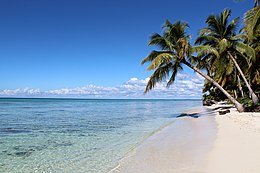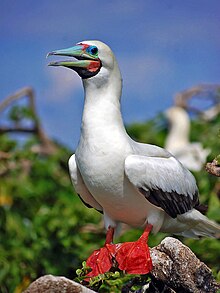Saona Island
Native name: Isla Saona | |
|---|---|
 Saona Island | |
| Geography | |
| Location | Caribbean Sea |
| Coordinates | 18°09′20″N 68°41′58″W / 18.15556°N 68.69944°W |
| Area | 110 km2 (42 sq mi) |
| Length | 25 km (15.5 mi) |
| Width | 5 km (3.1 mi) |
| Coastline | 47 km (29.2 mi) |
| Highest elevation | 35 m (115 ft) |
| Administration | |
| Province | La Romana |
| Demographics | |
| Population | 300 |
| Pop. density | 2.73/km2 (7.07/sq mi) |
Saona Island (Spanish: Isla Saona) is a 110-square-kilometer (42 sq mi) tropical island located off 1.5 miles (2.4 km) off the south-east coast in Dominican Republic's La Altagracia province. It is a government-protected nature reserve and is part of Cotubanamá National Park.[1] There are two permanent settlements, the town of Mano Juan and the naval base at Catuano. The island is a popular tourist destination in the Dominican Republic.
Etymology
[edit]Granberry and Vescelius (2004) suggest a Macoris etymology for the name Saona, comparing it with sa-ona 'full of bats' in the purportedly related Warao language of the Orinoco Delta.;[2] However, it is widely accepted that Christopher Columbus named it after the Italian city of Savona.[3]
History
[edit]Saona has pre-Columbian pictographs and petroglyphs found at Cueva de Cotubanamá.[4] The island was known as "Adamanay" by the indigenous Taino.[5] The island was baptized "Saona" by Christopher Columbus, who landed on it in May 1494[6] during his second voyage to the Americas. Columbus named Michele da Cuneo the first governor of the island.[7] The name was meant "... to honor Michele da Cuneo, [Columbus'] friend from Savona."[3] By 1500, the Tainos on the island provided Santo Domingo with most of its cassava.[8]
The island is the site of a series of shipwrecks dating back to the early Spanish control of the island. At least three vessels wrecked on the island due to storm, or piracy.[9]
Saona did not have permanent inhabitants until 1944, when the first buildings were constructed on the island.[10] Since then a village was established at Mano Juan which has homes for the local fishermen along with boutique hotels.[5][10]
Geography
[edit]Saona Island is located 1.5 miles (2.4 km) off the coast of peninsula that comprises the mainland section of the Cotubanamá National Park.[5] The island itself is 110-square-kilometer (42 sq mi) and is surrounded by the Caribbean Sea, with sandbars, and a number of coral reef ecosystems with a wide marine diversity.[4][5] The island itself is covered in white sand.[10] The northern coast of the island is more rugged, while the southern and western coasts hold the best open beaches on the island.[5] The island has multiple lagoons including the larger Secucho lagoon located inland and the Canto de la Playa and Las Flamencos lagoons on the southern part of the island.[11]
Flora and fauna
[edit]
Of the 539 registered species of endemic flora within the Cotubanamá National Park, most of them are found in the diversity of ecosystems on Saona including wild bushes and mangroves, semi-humid and salted forests. Four species of neotropical mangrove are present along the Catuano Channel - red, white, black, and button mangle.[12] The island also has large palm forests and lowland rainforest.[5]
112 species of birds are found on the island,[10] including brown pelicans, magnificent frigatebirds, flamingos, gulls, endemic Hispaniolan parrots, and red-footed boobies.
Saona is the Dominican Republic's most important site for sea turtle nesting.[5] The site is threatened by climate change and coastal flooding.[13] In the surrounding Caribbean Sea, 40 species of fish, 10 coral, and 124 mollusks can be found,[12] with other marine life including green sea turtles, loggerhead sea turtles, manatees, bottlenose dolphins, rhinoceros iguanas, and octopuses.
Municipalities
[edit]There are two permanent settlements, the towns of Mano Juan and Catuano. Mano Juan is the only inhabited village on the island. Catuano is the site of a naval base.[14] The island is powered entirely by renewable energy produced by a solar power plant that provides electricity to the 600 residents of the island.[15]
Economy
[edit]Saona Island is one of the key tourist locations in the Dominican Republic with over 1 million visitors per year.[16] It is the most visited protected area in the Dominican Republic, capturing 45% of the visits to protected areas in 2019.[4]
A secondary economy is based around film production. Films such as Pirates of the Caribbean: The Curse of the Black Pearl (2003) and The Blue Lagoon have been filmed in part on Saona Island.[10]
See also
[edit]References
[edit]- ^ "Ley 5597 de 1962 que modifica la ley 5220 de 1959" (PDF).
- ^ Granberry, Julian; Vescelius, Gary (2004). Languages of the Pre-Columbian Antilles. Tuscaloosa, Alabama: University of Alabama Press. ISBN 0-8173-5123-X.
- ^ a b Taviani, Paolo Emilio (1991). Columbus the Great Adventure. New York: Orion Books. p. 185.
- ^ a b c Dominican Republic's Tourist Destinations Report (PDF) (Report). Punta Cana: Ministerio de Turismo. April 2021. Archived (PDF) from the original on 2022-07-09.
- ^ a b c d e f g "Saona Island: a genuine Caribbean paradise". barcelo.com. Retrieved 27 November 2024.
- ^ "Saona Island". Bayahibe Village. Retrieved 2022-08-13.
- ^ Fernández-Armesto, Felipe (1991). Columbus. Oxford, United Kingdom: Oxford University Press. pp. 103–104.
- ^ Floyd, Troy (1973). The Columbus Dynasty in the Caribbean, 1492-1526. Albuquerque, New Mexico: University of New Mexico Press. p. 57.
- ^ Marx, Robert F. (1987). Shipwrecks in the Americas. New York City: Dover Publications. pp. 368, 370, 374. ISBN 0-486-25514-X.
- ^ a b c d e Taylor, Lauren (July 3, 2024). "How to holiday like a celebrity in the Dominican Republic's secret unspoilt island Saona". Irish News. Retrieved November 27, 2024.
- ^ "Saona Island – Complete Travel Guide 2022". Lopesan Costa Bávaro. Retrieved 27 November 2024.
- ^ a b "Saona Island, a paradisiacal place!". Visita Dominicana. Retrieved 27 November 2024.
- ^ Jacobo, Julia (20 April 2023). "Sea level rise could wash away turtle breeding grounds around the world, researchers say". ABC News. Retrieved 27 November 2024.
- ^ "U.S. plans to build a US$1.5 M naval base in Saona island". Dominican Today. 18 February 2012. Retrieved 27 November 2024.
- ^ "Saona Island already works 100% with renewable energy". Dominican Today. 5 January 2023. Retrieved 27 November 2024.
- ^ Hosteltur. "Gobierno dominicano anticipa un plan para relanzar Bayahíbe | Economía". Hosteltur: Toda la información de turismo (in European Spanish). Retrieved 2022-03-18.
External links
[edit] Media related to Saona Island at Wikimedia Commons
Media related to Saona Island at Wikimedia Commons


